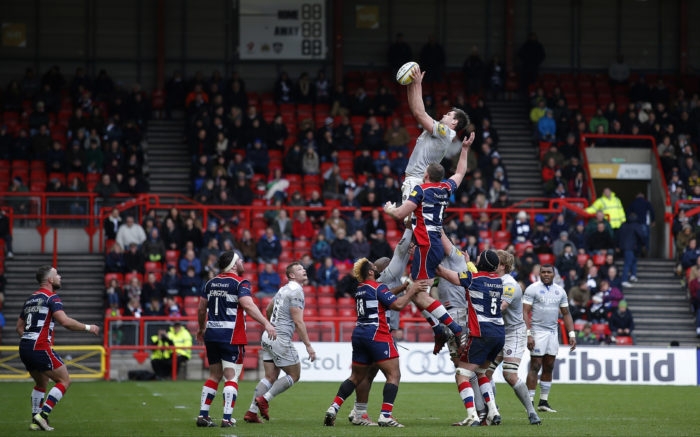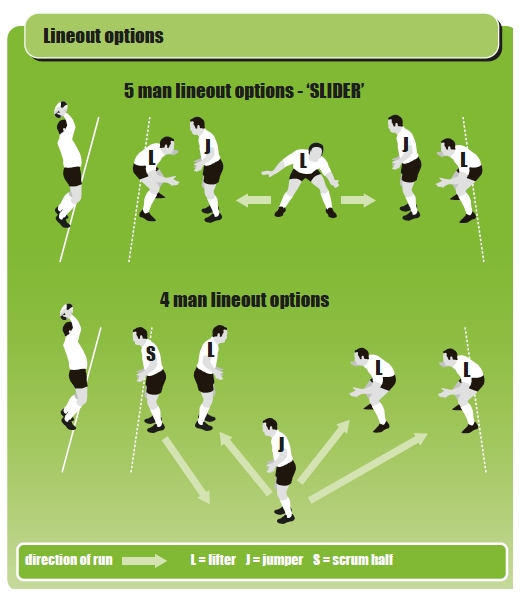How and when to use shortened lineouts

When to shorten the lineout
The reasons for shortening the lineout depend on the circumstances of the team, your tactics, your position on the field and the nature of the opposition:
- You might want to launch your big forwards (those not involved in the lineout) into the midfield.
- You might have difficulty in securing your own ball with a full lineout, for instance your jumpers are smaller or your thrower is mediocre.
- You might want to disrupt the opposition by varying your options through the game.
Where to use a shortened lineout
Certainly between the 22m lines, but special thought needs to be given about where else to use this tactic. The dangers of having a shortened lineout on the opposition line are that the defending side will have more numbers nearer to the lineout. However a well worked five man front peel (attacking inside the 5m channel and the touchline) can have an element of surprise here.
In your own 22m
- There will be fewer opposition forwards to put pressure on a clearance.
- The opposition is likely to be disrupted. They won't expect a shortened lineout in this area of the pitch.
- But... it's dangerous if it goes wrong. If the ball is lost in the lineout, your defence is poorly positioned to deal with an attack near to your line.
How to use a shortened lineout
A shortened lineout works well if the following work well.
Quick call and execution: Don't spend too much time setting up the lineout. The opposition might be able to counter the jumps if they have the chance to organise their numbers.
Quick feet: Power from the lifters is most effective when the feet are firmly planted, since the power comes first from the lower part of the body. The jumper needs to have a balanced jump to maximise the chance of a decent lift. Quick feet means getting the players' feet in the best position to perform their skill, and as quickly as possible.
In the lineout, the last metre or so movement requires the greatest number of steps per second – "footfall". In a shortened lineout, the jumper is likely to be moving more than in a full lineout, so both lifters and jumpers will need to maximise their footfall before a jump. This balances the players, and squares the feet and hips of the lifter and jumper.
Both jumpers and lifters need to be able to perform this running forwards and backwards. Use the 5m lines as practice areas to run between, with players coming to a dynamic halt. A jump at the end sees whether they are balanced or not.
Lineout moves, tactics and options
Six man lineout
Have a spare player in the backs who can either be a ball carrier or act as a decoy for your lineout plays.
Five man lineout
Have two jumpers, a dedicated lifter for each player and then have the man in the middle run to either jumper. As the illustration, the middle lifter (L) moves between the two jumpers (J), depending on where the opposition line up.

Three and four man lineouts
Option one: Leave big gaps between players who can act as lifters. Then the jumper moves towards one of the lifters, with the other lifter then joining on.
Option two: Have the jumper stand outside the line and then join, with the scrum half (9) who was standing in the line, then moving out. As the illustration, the jumper (J) joins the line away from an opponent. He calls one lifter's (L) name, who stays stationary, while the other lifter moves to support the jumper. S leaves line before the throw comes in.
Two man lineouts
Option one: The front man goes forwards then backwards to take a lob over the front, or vice versa to take a flat ball. On both occasions the back man stays well back in the line.
Option two: The ball is lobbed over the front man – who is coming forward at the time – to the scrum half or the player standing in the scrum half position. The back man stays at the back.
Option three: The scrum half joins the line and is lifted. The hooker acts as the scrum half to clear the ball away.
Newsletter Sign Up
Coaches Testimonials

Gerald Kearney, Downtown Las Vegas Soccer Club

Paul Butler, Florida, USA

Rick Shields, Springboro, USA

Tony Green, Pierrefonds Titans, Quebec, Canada
Subscribe Today
Be a more effective, more successful rugby coach
In a recent survey 89% of subscribers said Rugby Coach Weekly makes them more confident, 91% said Rugby Coach Weekly makes them a more effective coach and 93% said Rugby Coach Weekly makes them more inspired.
Get Weekly Inspiration
All the latest techniques and approaches
Rugby Coach Weekly offers proven and easy to use rugby drills, coaching sessions, practice plans, small-sided games, warm-ups, training tips and advice.
We've been at the cutting edge of rugby coaching since we launched in 2005, creating resources for the grassroots youth coach, following best practice from around the world and insights from the professional game.













